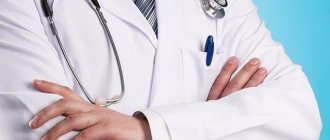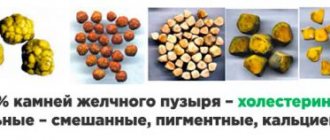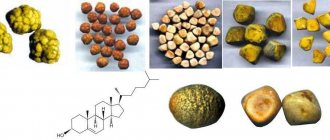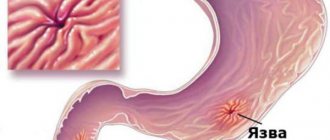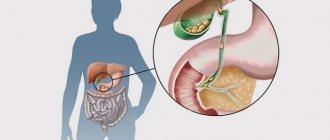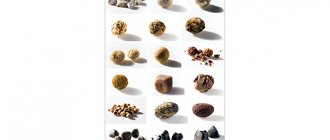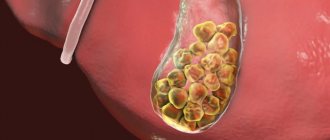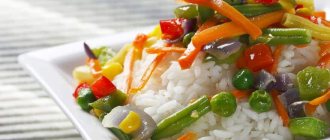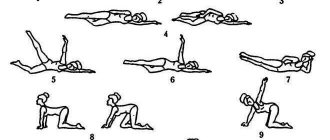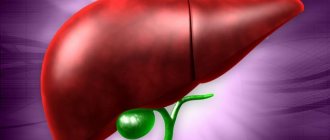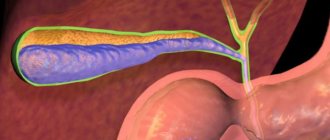Why does sand form in the gallbladder?
The organ functions as a vessel for storing bile produced by the liver. It promotes proper digestion of food. The main substances in bile are chlorine, sodium, cholesterol and trace elements. Under the influence of negative factors, the balance of elements is disrupted. As a result, the acidity level increases and leads to the formation of fine fractions - sand.
Reasons that can trigger the disease:
- poor nutrition;
- frequent stressful situations;
- diabetes mellitus and other endocrine disorders;
- excess weight;
- taking hormonal medications;
- gout;
- inflammatory processes in the gallbladder;
- atherosclerosis;
- starvation;
- frequent pregnancies;
- lack of physical activity, sedentary lifestyle.
The genetic predisposition of the body cannot be ignored. The type of metabolic processes is often inherited, due to this the possibility of exacerbation of cholelithiasis increases.
The symptoms of sand in women are no different from the symptoms in men. To prevent health problems, you should remember the signs of sand in the body.
Why does sand appear?
The gallbladder is a kind of reservoir in which concentrated bile produced by liver cells accumulates.
Our body needs bile for normal digestion. Under the influence of bile acids, fats are broken down and the absorption of carbohydrates and proteins is activated. The main components of bile are water and bile acids. The remaining part consists of phospholipids, bile pigments, cholesterol, organic anions, calcium, sodium, potassium, chlorine ions and other trace elements. Under the influence of unfavorable factors, the composition of bile secretion may change and then the components of bile begin to precipitate.
Causes
Doctors believe that the main reason that triggers the formation of stones in the gallbladder is metabolic disorders and an increase in the concentration of cholesterol in the blood. Metabolic changes cause the following conditions:
- diabetes;
- gout;
- atherosclerosis;
- bending or inflammation of the gallbladder;
- liver diseases;
- stagnation of bile in the biliary tract:
- pathologies of the gastrointestinal tract;
- diseases of the endocrine system;
- treatment with hormonal drugs.
Lifestyle also plays an important role. The development of the pathological process is facilitated by improper and unbalanced nutrition with a predominance of fatty, sweet and high-calorie foods or, on the contrary, prolonged fasting and hard diets. Often, problems with the gallbladder occur due to a sedentary lifestyle, obesity, under the influence of bad habits and chronic stress.
An equally important role is played by genetic predisposition to the disease. As you know, not only the color of eyes and hair, but also the type of metabolism is inherited. And if immediate relatives suffered from gallbladder pathologies, then the risk of gallstone disease increases significantly. If you pay close attention to your own health, you can always notice the first signs indicating the onset of a pathological process.
The main reason for the appearance of sand in gallstones is the increased cholesterol content in the human body.
It appears this way: while eating, the bladder constantly produces bile. The ratio of fluid and bile components is important.
If the proportions are violated, cholesterol will form, precipitate and form sand. Comprehensive treatment with medications and folk remedies will help remove it.
There are other reasons that can cause metabolic disorders and cause the disease:
- The patient inherited a predisposition to abnormal metabolism. Not all people whose relatives suffered from cholelithiasis can also suffer from it, but such patients have a high risk of the disease;
- Some diseases can disrupt metabolism. These include gout, diabetes mellitus, and atherosclerosis. In addition, pancreatic diseases can lead to the disease, and as a result, sand will appear in the gallbladder. It is important to treat ailments in a timely manner to prevent the appearance of sand;
- Malfunctions of the gastrointestinal tract can lead to the accumulation and stagnation of bile. Sand may form against this background. Increased gas formation will be a consequence of the accumulation of gases in the intestines, as a result of which bowel movements will occur irregularly. The intestine, which is overcrowded with feces, will exert internal pressure, which will lead to difficult movement of bile into the duodenum. If treatment is not carried out, the bile will become thicker and its composition will change;
- the patient has been diagnosed with a kinked gallbladder or inflammation of the organ;
- the patient does not follow the correct diet, overeats or goes hungry for a long time;
- the quality of food can affect the formation of cholesterol, which, falling in the gallbladder, forms sand. Foods that are undesirable to eat include fatty, sweet foods, high-calorie foods;
- the patient moves little, spends a lot of time sitting;
- the patient's endocrine system is not working properly;
- the patient was treated with a large number of hormonal drugs;
- a person drinks large amounts of alcoholic beverages;
- the patient’s age is more than 50–55 years, when changes occur in his body;
- the patient often found himself in stressful situations.
- The patient inherited a predisposition to abnormal metabolism. Not all people whose relatives suffered from cholelithiasis can also suffer from it, but such patients have a high risk of the disease;
- Some diseases can disrupt metabolism. These include gout, diabetes mellitus, and atherosclerosis. In addition, pancreatic diseases can lead to the disease, and as a result, sand will appear in the gallbladder. It is important to treat ailments in a timely manner to prevent the appearance of sand;
- Malfunctions of the gastrointestinal tract can lead to the accumulation and stagnation of bile. Sand may form against this background. Increased gas formation will be a consequence of the accumulation of gases in the intestines, as a result of which bowel movements will occur irregularly. The intestine, which is overcrowded with feces, will exert internal pressure, which will lead to difficult movement of bile into the duodenum. If treatment is not carried out, the bile will become thicker and its composition will change;
- the patient has been diagnosed with a kinked gallbladder or inflammation of the organ;
- the patient does not follow the correct diet, overeats or goes hungry for a long time;
- the quality of food can affect the formation of cholesterol, which, falling in the gallbladder, forms sand. Foods that are undesirable to eat include fatty, sweet foods, high-calorie foods;
- the patient moves little, spends a lot of time sitting;
- the patient's endocrine system is not working properly;
- the patient was treated with a large number of hormonal drugs;
- a person drinks large amounts of alcoholic beverages;
- the patient’s age is more than 50–55 years, when changes occur in his body;
- the patient often found himself in stressful situations.
Symptoms of sand in the gallbladder
The disease develops slowly, it is difficult to detect, and people do not know about it for a long time. You can suspect sand in the gallbladder if the following symptoms appear:
- disruption of the gastrointestinal tract;
- insomnia;
- change in the shade of the sclera;
- feeling of weakness and fatigue;
- increased body temperature for no apparent reason;
- memory impairment or decreased mental abilities;
- severe headaches that recur frequently;
- pain syndrome, it can appear for a short time and immediately disappear;
- bitterness in the mouth;
- chronic flatulence;
- discomfort or pain in the right hypochondrium;
- decreased appetite;
- pale skin may be accompanied by a sharp appearance of acne and increased secretion of sebum.
If the listed signs are noticeable, it means that the stage of stone formation has begun. An accurate diagnosis is made only after an ultrasound.
Occurrence of stones
Sand and stones in the gall bladder
Gallstone disease (hereinafter referred to as cholelithiasis) is an extremely common pathology in humans. The only diseases that are more common are diabetes and cardiovascular diseases. Among Americans, about a quarter of people have it. But in the Russian Federation, the statistics are a little more optimistic - in our country, about a fifth of the population suffers from problems with the gallbladder. On the other hand, with all the awareness about diseases such as heart attack, angina, varicose veins or other diseases of the heart and/or blood vessels, the population knows almost nothing really about gallstones. Otherwise, there would have been no trace of panic “out of the blue”, nor removal of the gallbladder, often performed without a hint of stones in this organ. We repeat: the latter is a gross violation of the Hippocratic Oath, as it exposes the patient’s health to enormous risk without need.
First of all, we will talk about the reasons for the appearance of cholelithiasis. Stagnation of bile and problems with cholesterol metabolism are “to blame” for the occurrence of this pathology. In other words, this is the same atherosclerosis, with the only difference that here all its processes take place in the biliary system. As cholesterol levels rise to unhealthy levels, bile becomes more viscous. The main risk factors here are heredity and genetics. Direct inheritance quadruples the risk of sand in the gallbladder. There is, for example, the South American tribe of Pima Indians - they have a genetic dilution of bile, due to which seven out of ten in the tribe suffer from cholelithiasis by the age of seventy.
Diagnostics
Detection of the disease is not limited to clinical signs. For diagnosis, you need to visit a gastroenterologist. The doctor will prescribe treatment based on:
- A detailed survey of the patient, during which the severity of symptoms and their danger to health are determined.
- Review of the patient's medical history. Disturbances in the functioning of the body can be caused by genetic predisposition. It is necessary to study the medical history of the patient's relatives.
- Physical examination. It includes palpation of the peritoneal area and assessment of the condition of the mucous membranes.
Laboratory methods are not important; they will not help make a diagnosis. In addition to communication between the specialist and the patient, examinations are carried out: ultrasound, computed tomography.
How to recognize the disease?
Sand in the gallbladder and ducts is not easy to identify, because symptoms, as a rule, are absent or not pronounced. The presence of sand in an organ can be determined using ultrasound. But in some cases, certain signs of the disease may still appear.
For example, headaches, insomnia and skin problems. The person will feel tired, and there will usually be a decrease in physical and mental activity. There is also poor tolerance to fried, fatty, spicy foods and alcoholic beverages. If you have the symptoms described above, you should definitely consult a doctor so that he can prescribe treatment. Otherwise, the organ will no longer contain sand, but stones.
How to treat?
Treatment of sand in the gallbladder and ducts is carried out using conservative methods. Your doctor may prescribe medications that will help normalize the amount of cholesterol in your bile. If possible, the patient should do physical exercise. They will not only help cope with obesity, but normalize metabolic processes.
Doctors also recommend that patients drink as much water as possible, approximately 12 glasses per day. You can add lemon slices to the water. This way you can cleanse your body. Juices made from carrots, beets and cucumbers are very useful for patients. It is recommended to drink three glasses a day of any juice from these vegetables for a week, then you can take a break and then continue treatment.
The appearance of sand in the gallbladder is a rather insidious and dangerous phenomenon that is practically asymptomatic. But if treatment is not started in time, stones may form, which are much more difficult to get rid of than sand. That is why, if you feel any changes in your health, you should consult a doctor.
Treatment without surgery
After collecting anamnesis and receiving research results, the specialist prescribes drug therapy. It will be aimed at quickly removing sand from the gallbladder without surgery. Treatment methods are used: procedures, medications, traditional medicine and proper nutrition.
Procedures
When diets and pills do not help, the doctor comes to the aid of more serious methods that allow you to expel sand from the gall bladder - laser and shock wave grinding of small stones.
Acupuncture
Acupuncture is used to remove sand. It reduces pain and has a beneficial effect on the restoration of gallbladder function. Acupuncture is not dangerous, but is allowed only in the absence of an inflammatory process.
It is advisable to undergo additional examination before sessions.
Drug treatment
It consists of using drugs that should eliminate congestive processes and normalize the functioning of organs:
- Agents that stimulate an increase in the amount of bile acids using liver cells. Ziflan is considered the most effective. It contains a plant extract of sandy immortelle, which has antispasmodic, hepatoprotective and choleretic effects. Medicines based on this plant reduce cholesterol levels. As a result of taking the tablets, the bile becomes more liquid, the composition of its components returns to normal, sand is removed, and small stones are destroyed. The medicine should be taken according to the regimen prescribed by the doctor under the supervision of a specialist, since large stones under the influence of immortelle can travel along the ducts and clog them.
- Litholytic agents. Cannot be taken simultaneously with oral contraceptives due to the estrogen content.
- Choleretic medications. If there is sand in the bladder, you cannot do without them, but you should take the tablets with caution. They cause colic and displacement of stones.
- Ursosan, Ursofalk and other tablets that normalize the physiological composition of bile eliminate stagnation, but there are contraindications for use - decreased bladder tone and the size of stones larger than 1.5 cm.
Ursosan
Ursofalk
To accelerate the positive effect, the doctor prescribes symptomatic medications: No-Shpa (antispasmodic), Analgin (analgesic).
How to get rid of sand in the gallbladder using folk remedies
Non-traditional means help improve organ function using safe methods. They are distinguished from medications:
- ease of use;
- minimal risk of side effects;
- no irritating effect on the gastrointestinal tract and other organs.
Before using any prescription, do not do without the approval of your doctor.
Oat decoction
Cleansing the body may be accompanied by side effects: tingling in the left hypochondrium and nausea.
To prepare the product you will need the following ingredients:
- 1 cup oats;
- 3 liters of boiled water.
The grains are washed and filled with water, boiled over low heat. Remove the container with the mixture from the stove after 30 minutes, leave until completely cooled, then filter. The decoction is consumed warm. During the day, drink up to one and a half liters of prepared liquid.
Lemon water
The recipe is simple. The juice of a medium lemon is squeezed into a liter of still water. You should drink as much fluid as possible within 12 hours. Course - 30 days.
Rose hip decoction
To obtain the product you will need 2 glasses of warm water and 1 tbsp. l. dried berries. The components are mixed and heated in a water bath for at least a quarter of an hour. After the time has passed, remove from the stove, remove the tea leaves and add water to the original volume.
Treatment is carried out in courses: 3 glasses per day for two weeks. Repeat after 30 days. You can use a thermos to brew rose hips. If the drink turns out to be too bitter, add water.
Dandelion root tea
The drink is useful if there is sand in the gallbladder, and is easy to prepare. 5 g of crushed roots are placed in a cup and poured with boiling water. Insist for half an hour. Tea can be consumed warm or cold.
Decoction of birch leaves
The drug is taken 15 ml before meals three times a day. 100 g of green birch leaves are poured with water, placed on the stove and boiled. After bubbles appear, the liquid is simmered for no more than 12-15 minutes. Then the broth is cooled and filtered using a sieve.
Corn silk
Pour 200 ml of boiling water 2 tbsp. l. stigma, boil for 15 minutes, cool, strain. The product is taken 1 tbsp. l. 4 times a day. The duration of treatment is 2 weeks.
Ready-made choleretic preparations
Pharmacies offer sets of choleretic herbs to improve the functioning of the gallbladder. They are brewed and drunk according to the instructions on the package.
Strawberries and wild strawberries
Fresh berries prevent the formation of congestion in the gallbladder. Dried ones are part of herbal preparations that gently remove sand from the body.
Features of treatment
Treatment of sand in the gallbladder is predominantly conservative. Many people make the mistake of ignoring the presence of sludge. But with heterogeneity of bile and fine suspension of particles, there remains a high risk of stone formation. Experts know how to treat sand in the gallbladder and how to remove it from the body.
Preparations Ursosan, Ursofalk
For this purpose, ursodeoxycholic acid preparations (Ursosan, Ursofalk) are most often used. They are prescribed in a standard dosage - 10 mg per kg of body weight once before bedtime for 1-3 months. After the course of therapy, it is necessary to re-perform ultrasound diagnostics.
Choleretic herbs and herbs
But ursodeoxycholic acid is not the only remedy that needs to be taken for biliary sludge. Sand in the gallbladder can be removed using special choleretic preparations or preparations based on certain herbs. An example of such a remedy is Gepabene. It is often recommended to those people who do not know how to expel sand from the gallbladder and cannot get rid of it for many years.
Gepabene and similar drugs, including conventional choleretic preparations, do not allow bile to stagnate, ensure its constant circulation and reduce lithogenicity. To enhance the effect of conservative treatment, it is recommended to additionally use ursodeoxycholic acid and regularly perform gallbladder tubing with sorbitol or magnesium sulfate. If, against the background of bile removal, bitterness appears in the mouth, it is recommended to use prokinetics (Motilium).
Duodenal intubation and surgery
If conservative therapy is ineffective, it is recommended to carry out minimally invasive treatment using duodenal intubation. Forced release of the gallbladder from lithogenic bile has a positive effect on the functioning of the entire biliary tract. If sand provokes the development of pancreatitis and other dangerous complications, it is necessary to perform cholecystectomy - surgical removal of the gallbladder.
Diet for sand and gallstones
For recovery, it is important to adhere to a therapeutic diet. Fried and fatty foods are prohibited. Dishes should be boiled, baked or steamed. All foods that, after processing, will become sources of cholesterol are excluded from the diet.
It is important to follow the rules:
- Eat 4-5 times a day in small portions.
- Most of the menu should consist of boiled vegetables and fresh fruits.
- Drink at least 2 liters of water per day.
- Chew food thoroughly.
- Monitor the temperature of cooked food. Food should not be too hot or cold.
- Carbonated drinks, coffee, fried foods, sweets, and pickled foods are excluded from the menu.
Oatmeal is healthy and is recommended to be consumed every morning. It cleanses the body and helps quickly eliminate sand from the gallbladder.
Permitted and prohibited products
Food during the diet should be of vegetable and dairy origin. Recommended to use:
- fresh fruits and vegetables;
- lean meat and poultry without skins;
- freshly squeezed carrot and cucumber juices;
- river fish;
- cereals, pasta from durum wheat;
- seafood;
- egg white;
- bananas, baked apples and pomegranates;
- dairy products;
- bread, dried to the state of crackers.
Among drinks, preference is given to alkaline mineral water, compotes of dried fruits and fresh berries, jelly (non-concentrated), and rosehip tea.
It is prohibited to use:
- canned meat;
- barley, pearl barley and millet porridge;
- sauces and mayonnaise;
- baking;
- alcohol-based drinks;
- fried fish and meat;
- any canned food and marinades with the addition of vinegar;
- food products with coloring components;
- fast food.
Prohibited: grapes, raspberries and currants. Strongly brewed tea, coffee and cocoa are also contraindicated.
Menu
A diet called “table No. 5” will help eliminate sand in the gallbladder. It provides the following menu (for 1 day):
- Breakfast: cottage cheese with finely chopped fruit (dried apricots). Weak tea with milk or honey.
- 2nd breakfast: green tea, dried bread with raisins or baked fruit.
- Lunch: puree soup based on green peas, buckwheat with chicken breast, dried fruit drink.
- Afternoon snack: freshly squeezed juices – pumpkin, carrot.
- Dinner: mashed potatoes with steamed fish, rosehip decoction.
- Before bed, a glass of kefir.
A healthy diet has a beneficial effect on the body and alleviates the symptoms of the disease. It is important to follow a diet not only during treatment, but also during the period of its weakening.
How is the disease treated?
Most often, patients are prescribed conservative treatment. Among the medications that the patient must take are agents that normalize the production of cholesterol in bile.
During treatment, the patient must perform physical exercises. With their help, the body's metabolism is normalized and excess weight will be reduced.
Diet is an important component of effective treatment.
Sweet products should also not be included in the diet, and you should also avoid drinking alcohol. It is recommended to consume a minimum amount of sugar and salt.
The patient should eat plenty of fruits and vegetables. The fiber they contain stimulates the digestion process.
All products must be boiled or steamed. It is strictly forbidden for patients to cook fried foods.
Patients who have sand in their gallbladder need to drink plenty of water. You can drop a little lemon juice into it. This way you can cleanse your body of sand.
Beetroot, cucumber and carrot juice are also beneficial for patients. It should be drunk several glasses a day for a week. After a short break, you can repeat the treatment with vegetable juice again.
Having started therapy, the patient will notice an improvement in his condition within a few days. But before undergoing treatment, it is recommended to consult a doctor.
Prevention
To reduce the risk of developing the disease, patients should follow the following recommendations:
- Change your diet. It is important to eliminate or reduce the amount of foods containing cholesterol.
- The menu should contain healthy fats: olive oil, seeds, avocado, nuts.
- Fiber intake: fresh vegetables and fruits, legumes, brown rice, whole grains.
- More water.
- Physical exercise.
- Do not starve or indulge in radical diets.
If a disease occurs, you should know how to remove sand from the gallbladder, how to behave and where to go. Medications, procedures, and healthy eating cannot be done on your own. Everything is prescribed by a gastroenterologist based on the condition of the body and the stage of the disease.
Folk recipes
It is good to treat sand in the gallbladder using traditional medicine methods. As a rule, such recipes are completely natural and harmless to human health; they will not impair the functioning of the liver or intestines or damage the walls of the stomach.
A good treatment is taking natural fresh juices. It is necessary to drink a glass of freshly squeezed beet, carrot or cucumber juice every day before meals. It is best to drink about 6-7 glasses of juice per day. This way the bladder will also begin to work actively.
Plain water with fresh lemon or lime juice has a good effect. To do this, you need to take a liter of clean still water and squeeze out the juice of a whole medium-sized lemon into it. Mix everything thoroughly and take in small portions throughout the day.
It is also good to make special herbal teas. Peppermint, rose hips, and regular chicory are best suited. A tablespoon of herb is poured into a glass of boiling water, the decoction is infused for an hour under a closed lid, then drunk at night. But as for chicory, you should drink it instead of coffee - this will not only remove sand from the gallbladder, but also make the body more resistant to other diseases.
If you have kidney or gallstones, you should eat oatmeal as often as possible. Oats help remove excess cholesterol from the body. But for medicinal purposes, it is best to use oatmeal that is not instant, but one that still needs to be cooked.
Sand in the gallbladder can appear in those people whose cholesterol levels are higher than normal. Most often, cholesterol levels are elevated in older people.
There are other reasons for the appearance of sand in the bladder: a person leads a sedentary lifestyle, eats poorly, and takes a large number of medications.
If you suspect the presence of sand in the organ, you should consult a doctor.
Manifestations of the disease
Sand can be removed from the gallbladder only after the cause of the disease becomes known. To make a correct diagnosis, it is necessary to recognize the symptoms of the disease. It should also be taken into account that the formation of sand in the bubble does not immediately make itself felt - the first symptom appears after some time. In addition, the initial signs are mild. That is why, for prevention, it is recommended to conduct an ultrasound examination of the abdominal cavity once every 6 months.
First of all, a person begins to notice periodic but severe headaches, and problems with sleep may begin. Under such circumstances, not a single drug helps in the fight against insomnia. Sometimes patients complain of disturbing dreams and nightmares, but nothing indicates a serious psychological state of the person.
The formation of sand in the bladder often makes it difficult to eat. Stagnation may occur because the duct is clogged, making it difficult for bile to pass into the bladder. Most often, people find it difficult to eat high-calorie foods (fatty, fried foods). After overeating, even a minor one, a person feels pain in the intestinal area, the patient may be bothered by a feeling of nausea and vomiting.
The main symptoms of the disease include excessive fatigue, loss of ability to work, and inability to concentrate for a long time. Sometimes memory problems begin.
A rash in the form of small purulent pimples may form on the face. Very often a person begins to treat them with various means, but they do not help in such cases.
